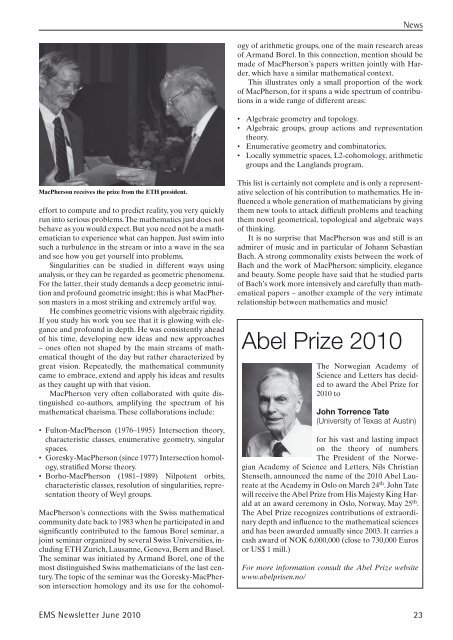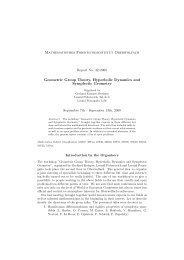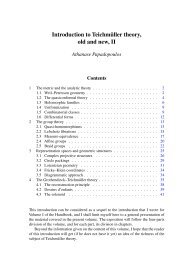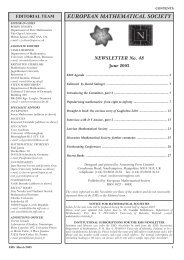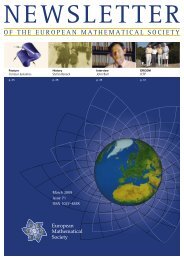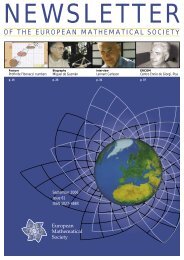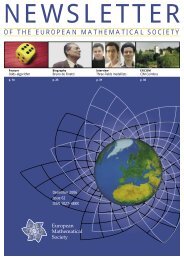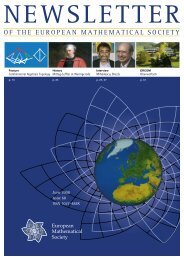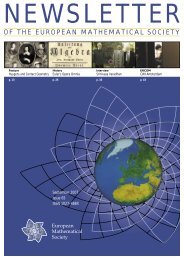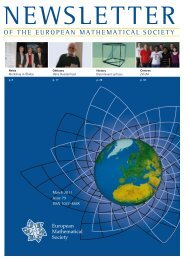EMS Newsletter June 2010 - European Mathematical Society ...
EMS Newsletter June 2010 - European Mathematical Society ...
EMS Newsletter June 2010 - European Mathematical Society ...
You also want an ePaper? Increase the reach of your titles
YUMPU automatically turns print PDFs into web optimized ePapers that Google loves.
MacPherson receives the prize from the ETH president.<br />
effort to compute and to predict reality, you very quickly<br />
run into serious problems. The mathematics just does not<br />
behave as you would expect. But you need not be a mathematician<br />
to experience what can happen. Just swim into<br />
such a turbulence in the stream or into a wave in the sea<br />
and see how you get yourself into problems.<br />
Singularities can be studied in different ways using<br />
analysis, or they can be regarded as geometric phenomena.<br />
For the latter, their study demands a deep geometric intuition<br />
and profound geometric insight; this is what MacPherson<br />
masters in a most striking and extremely artful way.<br />
He combines geometric visions with algebraic rigidity.<br />
If you study his work you see that it is glowing with elegance<br />
and profound in depth. He was consistently ahead<br />
of his time, developing new ideas and new approaches<br />
– ones often not shaped by the main streams of mathematical<br />
thought of the day but rather characterized by<br />
great vision. Repeatedly, the mathematical community<br />
came to embrace, extend and apply his ideas and results<br />
as they caught up with that vision.<br />
MacPherson very often collaborated with quite distinguished<br />
co-authors, amplifying the spectrum of his<br />
mathematical charisma. These collaborations include:<br />
• Fulton-MacPherson (1976–1995) Intersection theory,<br />
characteristic classes, enumerative geometry, singular<br />
spaces.<br />
• Goresky-MacPherson (since 1977) Intersection homology,<br />
stratified Morse theory.<br />
• Borho-MacPherson (1981–1989) Nilpotent orbits,<br />
characteristic classes, resolution of singularities, representation<br />
theory of Weyl groups.<br />
MacPherson’s connections with the Swiss mathematical<br />
community date back to 1983 when he participated in and<br />
significantly contributed to the famous Borel seminar, a<br />
joint seminar organized by several Swiss Universities, including<br />
ETH Zurich, Lausanne, Geneva, Bern and Basel.<br />
The seminar was initiated by Armand Borel, one of the<br />
most distinguished Swiss mathematicians of the last century.<br />
The topic of the seminar was the Goresky-MacPherson<br />
intersection homology and its use for the cohomol-<br />
News<br />
ogy of arithmetic groups, one of the main research areas<br />
of Armand Borel. In this connection, mention should be<br />
made of MacPherson’s papers written jointly with Harder,<br />
which have a similar mathematical context.<br />
This illustrates only a small proportion of the work<br />
of MacPherson, for it spans a wide spectrum of contributions<br />
in a wide range of different areas:<br />
• Algebraic geometry and topology.<br />
• Algebraic groups, group actions and representation<br />
theory.<br />
• Enumerative geometry and combinatorics.<br />
• Locally symmetric spaces, L2-cohomology, arithmetic<br />
groups and the Langlands program.<br />
This list is certainly not complete and is only a representative<br />
selection of his contribution to mathematics. He influenced<br />
a whole generation of mathematicians by giving<br />
them new tools to attack difficult problems and teaching<br />
them novel geometrical, topological and algebraic ways<br />
of thinking.<br />
It is no surprise that MacPherson was and still is an<br />
admirer of music and in particular of Johann Sebastian<br />
Bach. A strong commonality exists between the work of<br />
Bach and the work of MacPherson: simplicity, elegance<br />
and beauty. Some people have said that he studied parts<br />
of Bach’s work more intensively and carefully than mathematical<br />
papers – another example of the very intimate<br />
relationship between mathematics and music!<br />
Abel Prize <strong>2010</strong><br />
The Norwegian Academy of<br />
Science and Letters has decided<br />
to award the Abel Prize for<br />
<strong>2010</strong> to<br />
John Torrence Tate<br />
(University of Texas at Austin)<br />
for his vast and lasting impact<br />
on the theory of numbers.<br />
The President of the Norwegian<br />
Academy of Science and Letters, Nils Christian<br />
Stenseth, announced the name of the <strong>2010</strong> Abel Laureate<br />
at the Academy in Oslo on March 24 th . John Tate<br />
will receive the Abel Prize from His Majesty King Harald<br />
at an award ceremony in Oslo, Norway, May 25 th .<br />
The Abel Prize recognizes contributions of extraordinary<br />
depth and influence to the mathematical sciences<br />
and has been awarded annually since 2003. It carries a<br />
cash award of NOK 6,000,000 (close to 730,000 Euros<br />
or US$ 1 mill.)<br />
For more information consult the Abel Prize website<br />
www.abelprisen.no/<br />
<strong>EMS</strong> <strong>Newsletter</strong> <strong>June</strong> <strong>2010</strong> 23


